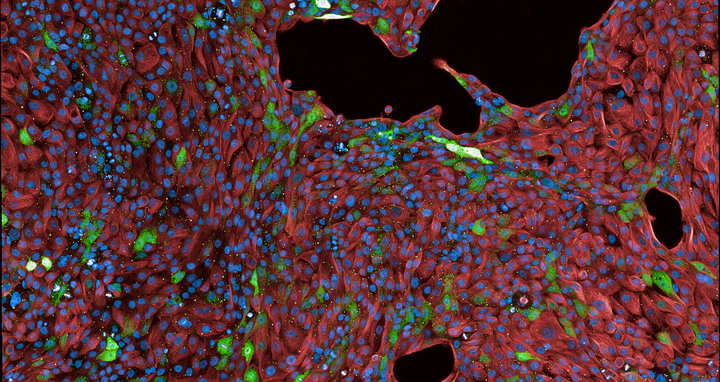Computer-engineered DNA to study cell identities
All the cells in our body have the same genetic code, and yet they can differ in their identities, functions and disease states. Telling one cell apart from another in a simple manner, in real time, would prove invaluable for scientists trying to understand inflammation, infections or cancers. Now, scientists at the Max Delbrück Center have created an algorithm that can design such tools that reveal the identity and state of cells using segments of DNA called “synthetic locus control regions” (sLCRs). They can be used in a variety of biological systems. The findings, by the lab of Dr Gaetano Gargiulo, head of the Molecular Oncology Lab, are reported in “Nature Communications.”
This algorithm enables us to create precise DNA tools for marking and studying cells, offering new insights into cellular behaviors.
“This algorithm enables us to create precise DNA tools for marking and studying cells, offering new insights into cellular behaviors,” says Gargiulo, senior author of the study. “We hope this research opens doors to a more straightforward and scalable way of understanding and manipulating cells.”
This effort began when Dr Carlos Company, a former graduate student at the Gargiulo lab and co-first author of the study, started to invest energy into making the design of the DNA tools automated and accessible to other scientists. He coded an algorithm that can generate tools to understand basic cellular processes as well as disease processes such as cancers, inflammation and infections.
“This tool allows researchers to examine the way cells transform from one type to another. It is particularly innovative because it compiles all the crucial instructions that direct these changes into a simple synthetic DNA sequence. In turn, this simplifies studying complex cellular behaviors in important areas like cancer research and human development,” says Company.
Algorithm to make a tailored DNA tool
The computer program is named “logical design of synthetic cis-regulatory DNA” (LSD). The researchers input the known genes and transcription factors associated with the specific cell states they want to study, and the program uses this to identify DNA segments (promoters and enhancers) controlling the activity in the cell of interest. This information is sufficient to discover functional sequences, and scientists do not have to know the precise genetic or molecular reason behind a cell’s behavior; they just have to construct the sLCR.
The program looks within the genomes of either humans or mouse to find places where transcription factors are highly likely to bind, says Yuliia Dramaretska, a graduate student at the Gargiulo lab and co-first author. It spits out a list of 150-basepair long sequences that are relevant, and which likely act as the active promoters and enhancers for the condition being studied.
“It's not giving a random list of those regions, obviously,” she says. “The algorithm is actually ranking them and finding the segments that will most efficiently represent the phenotype you want to study.”
Like a lamp inside the cells
In order to find treatment combinations that work for specific cell states in glioblastomas, you not only need to understand what defines these cell states, but you also need to see them as they arise.
Scientists can then make a tool, called a “synthetic locus control region” (sLCR), which includes the generated sequence followed by a DNA segment encoding a fluorescent protein. “The sLCRs are like an automated lamp that you can put inside of the cells. This lamp switches on only under the conditions you want to study,” says Dr Michela Serresi, a researcher at the Gargiulo lab and co-first author. The color of the “lamp” can be varied to match different states of interest, so that scientists can look under a fluorescence microscope and immediately know the state of each cell from its color. “We can follow with our eyes the color in a petri dish when we give a treatment,” Serresi says.
The scientists have validated the utility of the computer program by using it to screen for drugs in SARS-CoV-2 infected cells, as published last year in “Science Advances.” They also used it to find mechanisms implicated in brain cancers called glioblastomas, where no single treatment works. “In order to find treatment combinations that work for specific cell states in glioblastomas, you not only need to understand what defines these cell states, but you also need to see them as they arise,” says Dr Matthias Jürgen Schmitt, the researcher at the Gargiulo lab and co-first author, who used the tools in the lab to showcase their value.
Now, imagine immune cells engineered in the lab as a gene therapy to kill a type of cancer. When infused into the patient, not all these cells will work as intended. Some will be potent and while others may be in a dysfunctional state. Funded by an European Research Council grant, the Gargiulo lab will be using this system to study the behavior of these delicate anti-cancer cell-based therapeutics during manufacturing. “With the right collaborations, this method holds potential for advancing treatments in areas like cancer, viral infections, and immunotherapies,” Gargiulo says.
Text: gav
Further information
Picture to download
Decoding SARS-CoV-2 Response: LSD algorithm spotlights actively responding lung cells (green). Photo: Matthias Schmitt
Literature
Carlos Company, Matthias Jürgen Schmitt, Yuliia Dramaretska et al. (2024): “Logical design of synthetic cis-regulatory DNA for genetic tracing of cell identities and state changes”. Nature Communications. DOI: 10.1038/s41467-024-45069-6
Contacts
Dr Gaetano Gargiulo
Head of the Molecular Oncology Lab
Max Delbrück Center
+49(0)30-9406-3861
Gaetano.Gargiulo@mdc-berlin.de
Jana Schlütter
Editor, Communications
Max Delbrück Center
+49 30 9406-2121
jana.schluetter@mdc-berlin.de or presse@mdc-berlin.de
- Max Delbrück Center
The Max Delbrück Center for Molecular Medicine in the Helmholtz Association (Max Delbrück Center) is one of the world’s leading biomedical research institutions. Max Delbrück, a Berlin native, was a Nobel laureate and one of the founders of molecular biology. At the locations in Berlin-Buch and Mitte, researchers from some 70 countries study human biology – investigating the foundations of life from its most elementary building blocks to systems-wide mechanisms. By understanding what regulates or disrupts the dynamic equilibrium of a cell, an organ, or the entire body, we can prevent diseases, diagnose them earlier, and stop their progression with tailored therapies. Patients should be able to benefit as soon as possible from basic research discoveries. This is why the Max Delbrück Center supports spin-off creation and participates in collaborative networks. It works in close partnership with Charité – Universitätsmedizin Berlin in the jointly-run Experimental and Clinical Research Center (ECRC), the Berlin Institute of Health (BIH) at Charité, and the German Center for Cardiovascular Research (DZHK). Founded in 1992, the Max Delbrück Center today employs 1,800 people and is 90 percent funded by the German federal government and 10 percent by the State of Berlin.






